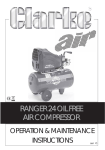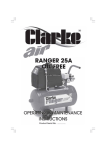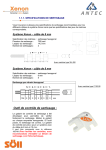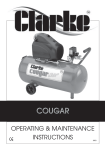Download Clarke SPYDER 3 Specifications
Transcript
SPYDER 3 & 7 OIL FREE AIR COMPRESSOR OPERATION & MAINTENANCE INSTRUCTIONS Serial/Batch No: ....................... © 0503 PARTS & SERVICE TEL: 020 8988 7400 SPECIFICATIONS Electrical Supply ..................................................... 230 V, 1 Phase 50Hz Motor Rating ............................................................ 1.5 HP Max. Air Pressure .................................................... 8 bar (116 lbf/in2) Air Displacement .................................................... 6.3 cuft/min Air Receiver Spyder 3 .......................................... 2 litre Spyder 7 .......................................... 6 litre Nett Weight Spyder 3 .......................................... 10.5kg Spyder 7 .......................................... 14kg Dimensions Spyder 3 .......................................... 350x260x470 (LWH) Spyder 7 .......................................... 380x200x420 (LWH) Duty Cycle ............................................................... S3 - 40% at Max 7bar* * The compressor may only be operated continuously for 4 minutes in any period of 10 minutes, when output is max. 7 bar. Part Numbers Spyder 3 2330006 Spyder 3 w/Spray Gun Spyder 7 2330011 2330016 Spyder 7 w/Spray Gun 2330021 Please note that the details and specifications contained herein, are correct at the time of going to print. However, CLARKE International reserve the right to change specifications at any time without prior notice. Always consult the machine’s data plate © Copyright CLARKE International. All rights reserved. March, 2001 -2- - 19 - For a professional looking finish paint must be thinned. If the manufacturers recommendations on thinning are not available, the following can be used as a general guide: Water based paints (emulsions) - 10-20% water Oil based paints (gloss) - up to 10% white spirit thinners Cellulose paints - up to 50% cellulose thinners 3. HANDLING THE GUN The first requirement for a good resultant finish is the proper handling of the gun. The gun should be held perpendicular to the surface being covered and moved parallel to it. The stroke should be started before the trigger is pulled and the trigger should be released before the stroke is ended. This gives accurate control of the gun and material. The distance between gun and surface should be 6 to 12 inches depending on material and atomizing pressure. The material deposited should always be even and wet. Lap each stroke over the preceding stroke to obtain a uniform finish. NOTE: To reduce overspray and obtain maximum efficiency, always spray with the lowest possible atomizing air pressure. Thank you for purchasing this CLARKE SPYDER Oil Free Air Compressor, which is designed for hobby and DIY use only. Please read this leaflet thoroughly and carefully follow all instructions. In doing so you will ensure the safety of yourself and that of others around you, and you can look forward to the compressor giving you long and satisfactory service. GUARANTEE This product is guaranteed against faulty manufacture for a period of 12 months from the date of purchase. Please keep your receipt as proof of purchase. This guarantee is invalid if the product is found to have been abused or tampered with in any way, or not used for the purpose for which it was intended. Faulty goods should be returned to their place of purchase, no product can be returned without prior permission. This guarantee does not effect your statutory rights. CONTENTS Page Specifications ............................................................................ 2 Safety Precautions ..................................................................... 4 4. SPRAY GUN MAINTENANCE 1. Immerse only the front end of the gun until solvent just covers the fluid connection. 2. Use a bristle brush and solvent to wash off accumulated paint. 3. Do not submerge the entire spray gun in solvent because: a. the lubricant in the gland packings will dissolve and the packings will dry out. b. the lubricant will dissolve causing harder operation and faster wear. c. residue from dirty solvent may clog the narrow air passages in the gun. 4. Wipe down the outside of the gun with solvent dampened rag. 5. Lubricate gun daily. Use a light machine oil on: a. fluid needle packing. b. air valve packing. c. fan control packing. d. trigger pivot point. Coat the fluid control spring with vaseline. Caution: Never use lubricants containing silicone as this may cause finish defects. - 18 - Electrical Connections .............................................................. 5 Operating Instructions ............................................................... 6 Routine Maintenance ................................................................ 7 Accessories ................................................................................ 9 Troubleshooting ....................................................................... 10 Parts List (Pump) ....................................................................... 12 Parts Diagram (Pump) ............................................................. 13 Parts List (Receiver) ............................................................ 14 Parts Diagram (Receiver) ................................................... 15-16 Paint Spraying Hints - General preparation ......................... 17 Preparing the paint ........................... 17 Handling the gun .............................. 18 Spray gun maintenance .................. 18 Declaration of Conformity ...................................................... 19 -3- SAFETY PRECAUTIONS WARNING As with all machinery, there are certain hazards involved with their operation and use. Exercising respect and caution will considerably lessen the risk of personal injury. However, if normal safety precautions are overlooked, or ignored, personal injury to the operator, or damage to property may result. It is in your own interest to read and pay attention to the following rules: ✗ ✗ ✗ ✗ ✗ ✗ ✗ ✗ ✔ ✔ ✔ ✔ ✔ ✔ ✔ ✔ ✔ COMPRESSED AIR IS DANGEROUS, NEVER direct a jet of air at people or animals, and NEVER discharge compressed air against the skin. NEVER operate your compressor with any covers removed. NEVER carry out any electrical or mechanical repairs unless you are qualified to do so. If problems occur, contact your Clarke dealer. NEVER leave pressure in the receiver overnight, or when transporting. NEVER adjust, or tamper with the safety valves. The maximum pressure is factory set, and clearly marked on the machine. NEVER operate in wet or damp conditions. Keep the machine dry at all times. NEVER use in dusty, dirty or paint spray locations. A clean atmosphere will ensure efficient operation. NEVER exert any strain on electrical cables and ensure that air hoses are not tangled or wrapped around machinery etc. ALWAYS expel all air from the receiver, and disconnect the machine is from the mains. BEFORE carrying out any maintenance. ALWAYS exercise care when touching components...some of the metal parts can become quite hot during operation. Wait until the machine has cooled down. ALWAYS adjust the pressure regulator to the recommended setting for the particular spray gun or tool being used. ALWAYS ensure there is adequate ventilation when spraying inflammable materials e.g. cellulose paint, and keep clear of any possible source of ignition. ALWAYS protect yourself. Think carefully about any potential hazards which may be created by using the compressor and use the appropriate protection. e.g. Goggles will protect your eyes from flying particles. Face masks will protect you against paint spray and/or fumes. (Personal safety products can be obtained from your local Clarke dealer). ALWAYS consult paint/product manufacturers instructions for safety and usage before spraying any material ALWAYS ensure that the air supply is turned off at the machine outlet and expel all pressurised air from within the machine and other equipment attached to it, BEFORE disconnecting air hoses or other equipment from your compressor. ALWAYS exercise vigilance to ensure that children and animals are kept well away from the compressor and any equipment attached to it. ALWAYS ensure that all individuals using the compressor have read and fully understand these Operating Instructions. -4- PAINT SPRAYING HINTS WARNING NEVER attempt to spray unless you are wearing suitable, approved respiratory and eye protection. REMEMBER that some modern paints require specialist respiratory protection...always consult the paint manufacturers instructions. 1. GENERAL PREPARATION a. Ensure that the area in which you will be spraying is clean and dust free. b. Connect spray gun to compressor via suitable flexible hose. c. With no paint in spray gun, test system for air leaks. d. Cover adjacent pieces of equipment to prevent overspray. Mask areas of the article not to be sprayed. e. Ensure surface to be painted is clean, dry and free from oil and dust. Check paint manufacturer’s instructions for any special surface preparation required. REMEMBER - TIME SPENT PREPARING SAVES TIME SPENT FINISHING 2. PAINT PREPARATION a. Achieve the correct paint viscosity. This should be done according to paint manufacturer’s instructions, and will vary according to type of paint. b. Having mixed the paint thoroughly in a separate container, pour into the spray gun paint container through a fine filter. DO NOT OVERFILL SPRAY GUN PAINT CONTAINER - three quarters full is maximum c. It is usually best to experiment with a couple of practice spray coats on a piece of material with the same type of surface as the article you wish to spray, eg. metal for a car body panel, wood for a piece of furniture etc. d. Some common problems: PROBLEM Paint does not atomise (comes out in blobs) CAUSE Paint is too thick, air pressure is too low. Paint dries before hitting Paint is too thin. Air surface, leaving it dry pressure is too high with a rough texture Finish is pitted like Orange peel work CORRECTION Add thinners. Increase air press. (not above 50 psi, unless specified by paint manuf. Add more paint. Reduce air pressure Air pressure too high Reduce air pressure, or spray too close to increase distance between gun and work. - 17 - PARTS DIAGRAM - RECEIVER AND COMPONENTS A. SPYDER 7 ELECTRICAL CONNECTIONS Connect the mains lead to a standard, 230 Volt (50Hz) electrical supply through an approved 13 amp BS 1363 plug, or a suitably fused isolator switch. WARNING! THIS APPLIANCE MUST BE EARTHED IMPORTANT: The wires in the mains lead are coloured in accordance with the following code: Green & Yellow Blue Brown - Earth Neutral Live As the colours of the flexible lead of this appliance may not correspond with the coloured markings identifying terminals in your plug proceed as follows: • Connect GREEN & YELLOW cord to terminal marked with a letter “E” or Earth symbol “ ” or coloured GREEN or GREEN & YELLOW. • Connect BROWN cord to terminal marked with a letter “L” or coloured RED. • Connect BLUE cord to terminal marked with a letter “N” or coloured BLACK. If this appliance is fitted with a plug which is moulded onto the electric cable (i.e. non-rewireable) please note: 1. The plug must be thrown away if it is cut from the electric cable. There is a danger of electric shock if it is subsequently inserted into a socket outlet. 2. Never use the plug without the fuse cover fitted. 3. When replacing a detachable fuse carrier, ensure the correct replacement is used (as indicated by marking or colour code). 4. Replacement fuse covers can be obtained from your local dealer or most electrical stockists. FUSE RATING The fuse in the plug must be replaced with one of the same rating (13 amps) and this replacement must be ASTA approved to BS1362. We strongly recommend that this machine is connected to the mains supply via a Residual Current Device (RCD) If in any doubt, consult a qualified electrician. DO NOT attempt any repairs yourself. - 16 - -5- OPERATION (Numbers in brackets refer to fig. 1 below) Before connecting your Spyder to the mains supply, check the following:• The mains voltage is 230V. • The ON/OFF control knob (B) is in the OFF (inner) position. • The pressure regulator (E) should be set at its lowest setting, i.e. turned fully anticlockwise, and the tap (F) screwed IN to its closed position. • If the machine has not been used for 24 hours or so, open the air receiver drain valve (A) and turn it on its end in order to drain any condensate which may have accumulated. When clear, close the valve, finger tight. PARTS DIAGRAM - RECEIVER AND COMPONENTS A. SPYDER 3 IMPORTANT: If the receiver is under pressure, keep your hands well away from the air being expelled.... remember, compressed air is DANGEROUS! Spyder 3 A. B C. D. Fig.1 Spyder7 Air Receiver Drain Valve ON / OFF Knob Pressure Switch and Cutout Receiver Pressure gauge E F G H Air Pressure Regulator Knob Air Outlet Tap Quick Fit Coupling Nut Non-Return Valve Now connect a suitable air hose, fitted with quick-fit adaptors, between the air outlet (G) and the spray gun or air tool being used. Ensure that the rubber washers are in place to form the necessary air tight seals. These fittings should be screwed by hand but take care not to over tighten. If a rubber seal is damaged then it should be replaced. If you do not wish to use the Quick Fit method of hose connection, simply remove the Quick Fit nut and use an air hose fitted with conventional 1/4 BSP connectors. Once the hose connections are complete, CHECK AGAIN to ensure the pressure regulator (E) is turned fully anticlockwise so that compressed air cannot reach the air tool, then plug the machine into the mains and switch ON, by pulling the ON/ OFF knob (B) out, until it clicks into position. The air compressor will now start, and pressure will build up in the receiver to a regulated max. pressure of 8 Bar (116 psi). Should the motor fail to start immediately, it is probable that the air receiver is already full of air. Check the pressure gauge (D). If you release air, by opening the drain valve (A), the motor will start automatically once the cut-in pressure is reached. -6- - 15 - PARTS LIST - RECEIVER AND COMPONENTS A. SPYDER 3 No. Description 1 2 3 4 5 6 7 8 9 10 11 12 13 14 15 16 17 18 19 20 Qty Drain cock 3/8 Vibration damper support Screw M5x15 Tank 2 lt. Delivery tube Rilsan tube Safety valve Elbow R1/4" Pressure gauge Ø40 Nipple 1/4" Pressure reducer with line cock Pressure switch Power cable with BSI plug Straight adapter Seal Spring Gasket Non-Return Valve Vibration damper support OL185 Compressor complete 1 1 2 1 1 1 1 1 1 1 1 1 1 1 1 1 1 1 1 1 Part No. FN022020000 FN020201000 FN014013042 FN126HU0010V FN129HU0010 FN046001000 FN347022000 FN011002000 FN330006000 FN011017000 FN319044000 FN321028000 FN101GA0200 FN199626000 n/a n/a n/a FN347060000 FN020202000 FN516HP01604 n/a - not available B. SPYDER 7 No. Description 1 2 3 4 5 6 7 8 9 10 11 12 13 14 15 16 17 18 Qty Drain cock 3/8 Vibration damper support Screw M5x15 Tank 6 lt. Delivery tube Rilsan tube Seal Spring Gasket Non-Return Valve Vibration damper support Nipple 1/4" Pressure switch Pressure gauge Ø40 Safety valve Power cable with BSI plug Pressure reducer with line cock OL185 Compressor complete 1 1 2 1 1 1 1 1 1 1 2 2 1 1 1 1 1 1 - 14 - Part No. FN022020000 FN020201000 FN014013042 FN126HU0011V FN129HU0011 FN046001000 n/a n/a n/a FN347060000 FN020202000 FN011017000 FN321028000 FN330006000 FN347022000 FN101GA0200 FN319044000 FN516HP01604 If this is not the case, it is possible that the overload cutout has intervened. This is a safety device to prevent the motor from overheating. The device will reset when the temperature falls to a predetermined level. In this event, switch OFF the machine and wait for 5 -10 minutes, before pressing the RESET button , mounted on the top cover, and clearly marked, and is shown in Fig.2.. Switch ON the machine and try again. If the motor fails to start, after several attempts, consult your Clarke dealer. Once the machine has started, turn ON the air supply to your air tool by opening the tap (F), and turn the pressure regulator (G) clockwise so that your chosen setting, shown on the label on top of the regulator knob, is in line with the inverted vee mark on the underside side of the casting. Note that the pressure gauge registers the pressure in the receiver only. IMPORTANT: As no outlet pressure gauge is fitted to this model, the marks on the Pressure Regulator provide an indication ONLY of the output pressure. If you are using pressure sensitive tools or equipment, you should insert a pressure gauge in the airline. Check to ensure that there are no air leaks at any of the couplings or in other parts of the system before operating the spray gun or air tool in the normal way. When the compressor reaches its maximum working pressure, the motor will automatically cut out, and will restart when the pressure has fallen by approximately 20 psi. This automatic STOP/START process will continue, as necessary, to maintain pressure in the receiver. When you have finished the job in hand ALWAYS switch OFF at the ON/OFF switch, NOT the mains supply, and release any pressure remaining in the system by opening the drain valve until all air is expelled. ALWAYS operate the air tool to further ensure that there is no pressure in the system BEFORE disconnecting the tool. Finally, reset the pressure regulator to zero by turning the regulator knob fully anticlockwise. ROUTINE MAINTENANCE IMPORTANT: Before carrying out any maintenance, always disconnect the machine from the mains supply, drain the air receiver and, if necessary, allow the machine to cool down before starting work. Daily Before use, always open the drain valve and tip the machine on to its end. Hold in that position until all condensate has drained off. Do not rest machine on the drain valve. Monthly It is important to keep the compressor clean, with the help of a small soft brush and vacuum cleaner. In particular, the air intake filter should be inspected at least MONTHLY, and more often in dusty conditions, so that it is always kept free of any dirt -7- particles, which, if not cleaned away, will affect the performance of the machine. Fig. 2 PARTS DIAGRAM - PUMP To clean the air intake filter, carefully prise out the sponge element shown in fig.2. Clean the sponge and the housing using a brush or clean lint free cloth. SPYDER 3 AND SPYDER 7 If necessary, the sponge filter may be gently washed in warm soapy water, rinsed and allowed to dry thoroughly before refitting. Every 500 hours of operation or every 6 months • Clean all the external parts of the compressor. (This cleaning makes the cooling process more efficient and prolongs the life of the machine). Fig. 3 • Examine the non-return valve and renew if necessary (fig. 3) (Ref: H Fig. 1, Item 18 page 15, and Item 10, page 16,) • In the event of an air leak follow the procedure below: • Load compressor to maximum pressure • Unplug the compressor • With a brush and soapy water wet all ‘screwed’ air connections • Any leaks will show through the formation of air bubbles. • Replace the piston (See your Clarke dealer) WARNING NEVER UNSCREW A CONNECTION WHILST THE AIR RECEIVER IS UNDER PRESSURE. ALWAYS MAKE CERTAIN THAT THE TANK HAS FIRST BEEN EMPTIED. -8- - 13 - PARTS LIST - PUMP No. Description 1 2 3 4 5 6 7 8 9 10 11 12 13 14 15 16 17 18 19 20 21 22 23 24 25 26 27 Housing Main Shaft Crank Bearing Rotor Stator Bearing Housing Bearing Bolt M5 Fan Circlip Distance Piece Bearing Con-Rod Special Bolt Gasket Nut Cylinder Head Screw M8 Capacitor Compl. Overload/Reset Valve Nut Filter Element Cover Cover ACCESSORIES Qty Part No. 1 1 1 1 1 1 1 1 3 3 1 1 1 1 1 1 1 2 1 2 1 1 1 1 1 1 1 FN116HP0001 FN116HP0002 FN116HP0003 FN033047000 FN034139000 FN316HP1604 FN033005000 FN116120007 FN014002124 FN014003003 FN116120008 FN015083000 FN014005069 FN033055000 FN416HP0004 FN116HP0005 FN116120013 FN014003001 FN416HP0007 FN014001056 FN009200004 FN008277000 FN011117000 FN116HP0011 FN116120017 FN116HP0008 FN116HP0009 Your Clarke Spyder Oil Free Air Compressor can be used in conjunction with a range of optional accessories for inflating tyres, air brushing, stapling, blowing and many other uses. For details contact your local accessory stockist. A complete kit is available from your Clarke dealer which is ideal for almost all applications. Please quote part number 3110165 Should you experience any difficulties obtaining accessories, please contact the Clarke sales department (telephone 01992 565300) for details of your nearest dealer. Should you wish to renew the Spray Gun and/or Hose, supplied with the models which include the Spray Outfits......the part numbers are as follows: Spraygun PS ................................. Part No. 5080813 Hose JP3 ....................................... Part No. 3120203 SPARE PARES AND SERVICE CONTACTS For Spare Parts and Service, please contact your nearest dealer, or CLARKE International, on one of the following numbers. PARTS & SERVICE TEL: 020 8988 7400 PARTS & SERVICE FAX: 020 8558 3622 or e-mail as follows: PARTS: [email protected] SERVICE: [email protected] - 12 - -9- TROUBLE SHOOTING With considerate use, your CLARKE Air Compressor should provide you with long and trouble free service. Routine checks should be made on both the electrical supply as well as the compressed air lines and connections. If any fault appears, the reason for which is not immediately obvious, please contact your local CLARKE Dealer. PROBLEM The compressor stops and will not start again. The compressor does not reach the set pressure and overheats easily. PROBABLE CAUSE REMEDY Bad connections. Check electrical connections. Clean and tighten as necessary. Overload cutout switch has tripped. Switch off and wait 5 Motor windings burnt out. Contact your local dealer for a replacement motor. Compressor head gasket blown or valve broken. Contact your CLARKE dealer. minutes before switching on. Parts Lists and Diagrams & Spraying Hints and Tips Replace Piston (contact your CLARKE dealer) Worn Piston Compressor does not start. Air receiver charged Open drain cock to expel air. Compressor should start again when pressure reduces to approx. 95 psi. Air leaking from the pressure switch valve when the compressor is not running. Faulty non-return valve. First drain the receiver completely. Replace nonReturn Valve Air pressure from regulator will not adjust. The diaphragm within the regulator body is broken. Replace Regulator CAUTION Do not attempt any repair or adjustment if you are uncertain as to how it should be done. If you have any queries, contact your local CLARKE Dealer. - 10 - - 11 -













